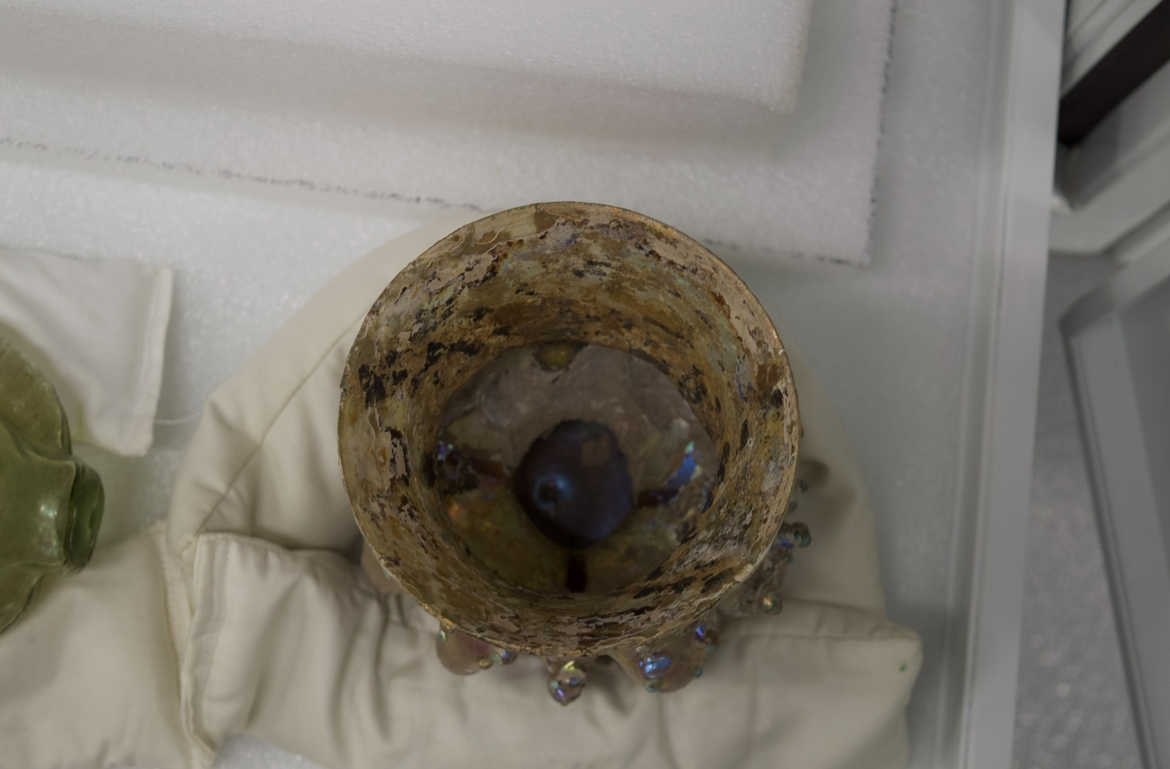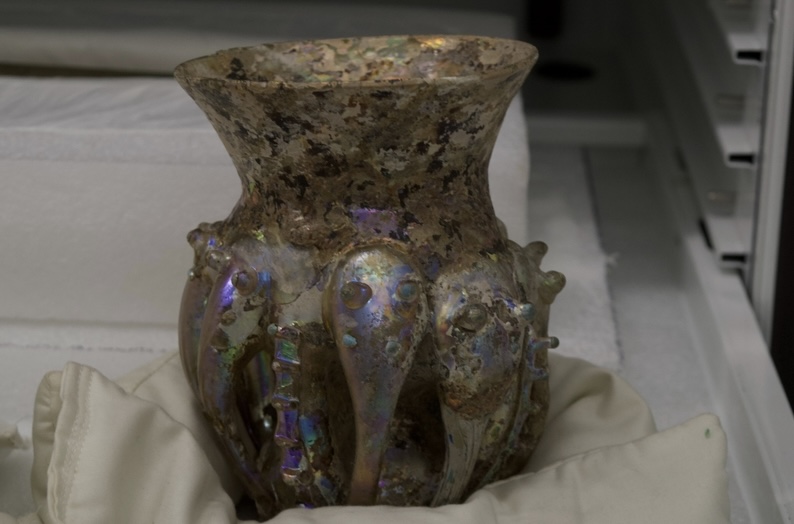Real, fake, stolen? Yale University’s collections under scrutiny
Curators, students and scholars are pushing for transparency, ethical collecting and repatriation at Yale museums including the YUAG and the Peabody.

Kamini Purushothaman, Contributing Photographer
A glass vase featuring multiple elephant heads might look, to the average viewer, like an authentic Roman-Byzantine work. But the Yale University Art Gallery’s “Funnel-Mouthed Vessel with Elephant Heads” is actually a fake — sort of. The piece is indeed made of glass from the 3rd to 5th century AD, but closer examination reveals glue that binds its glass pieces together. It was actually constructed in the 19th or 20th century, according to Lisa Brody, the associate curator of ancient art at the YUAG.
“You could call it a forgery, but it’s actually an amalgamation of different ancient glass pieces,” Brody said. “The final product is not authentic, but the pieces are.”

That gray area — between authenticity and artifice — reflects the broader ambiguity surrounding how objects are acquired, displayed and maintained across several University-operated museums. From questionable acquisitions to repatriated artifacts, the University has increasingly had to contend with the histories behind the objects it houses.
Authentication challenges at the YUAG
Brody, who works with the YUAG’s collection of ancient Mediterranean art, said that authentication is particularly difficult for ancient objects. Even with recent scientific developments, it can be challenging to claim with certainty whether an object is real or not. Moreover, the materials from which many ancient objects are made each present their own challenges when it comes to dating.
With marble, an isotope analysis could tell you what quarry it came from, but not its age. With bronze, you can run tests to determine its composition, but not its date of origin. The accuracy of thermoluminescent dating for pottery might be hindered by subsequent kiln-firings. Some residual organic materials — such as charcoal residue left in an ancient pot — can be carbon-dated, but are uncommon.
As evidenced by the “Funnel-Mouthed Vessel with Elephant Heads,” the line between authentic and inauthentic is itself challenging to identify.
Some inauthentic pieces, such as plaster casts of real artifacts, are used for educational purposes, Brody said.
Pointing to other examples of ambiguity in the YUAG’s collection, Brody highlighted a likely portrait of the disgraced Emperor Nero, which was recarved after his death but still within the Roman period. She also noted that some ancient portraits were recarved or restored during the Renaissance. Situations like these, she said, present a difficult question.
“If it’s ancient but has had work done to it, is it no longer ancient anymore?” Brody asked.
Another reason objects might be difficult to authenticate is that forgers can be extremely skilled, often matching the tools and techniques of ancient artisans.
She said that sometimes there is “no test” to definitively determine whether a piece of art was made in 200 B.C. or in 1923. Instead, this assessment is often enacted by experienced curators, who have the ability to “look at a sculpture and think something is off about it.”
Denise Leidy, curator of Asian art, echoed Brody’s assertion.
“I’m absolutely convinced that everything that’s on view upstairs is real,” Leidy said, referring to the Asian art exhibit at the YUAG. “There’s this sort of drive in my brain filled with images … so if an object doesn’t look right, then I do research.”
For Leidy, scientific testing is often a valuable tool for refining dating accuracy for pieces in the YUAG’s Asian art collection. She said that such assessments are a “constant process” that involves collaborating with international scholars to make adjustments based on new information and scientific data. Most of the time, errors relate to alterations to an object affecting its true origin date, rather than learning that a piece is truly a fake.
Leidy cited a series of Jain paintings in the YUAG’s collection, which she originally believed were from the 16th century. However, after a faculty member raised questions about the accuracy of the language used in the works, she conducted XRF testing — a noninvasive technique that can help estimate the date of origin by identifying modern materials unavailable in earlier periods. The results revealed that some of the paintings were actually from the 20th century. The object records on the YUAG’s website were subsequently updated to reflect this development.
Provenance: Where do objects in Yale’s collection come from?
Provenance, which refers to the ownership history of a piece of art or artifact, has become an increasingly relevant field in the museum world.
Brody said that, in recent years, the gallery has made strides to be “as diligent as possible” when it comes to researching the provenance of its collections. That includes adding provenance information to the online database and reevaluating objects acquired or donated, especially those acquired before the rise of modern collecting standards.
Brody often works with Mediterranean and Near Eastern antiquities, a collection which contains many artifacts and artworks that have been excavated by Yale-affiliated archeologists. The Yale-France excavations, which took place in the 1920s and 1930s, account for over 12,000 artifacts now housed in the YUAG’s collection. And because those digs were officially sanctioned and jointly organized, the objects they yielded are accompanied by complete provenance records.
But not every object in the YUAG’s collection comes with such clarity.
For Leidy, provenance is not a significant part of day-to-day work. As the head of the Asian Art department, she said her involvement with provenance comes primarily when acquiring new pieces.
“Most American museums are built on gifts,” said Leidy. “So when I want to accept a gift, I do some provenance research.”
When offered a donation, Leidy said she first evaluates whether it adds value to the collection. If she decides it does, she works with the donor to establish a documented ownership history. But often, that is not entirely possible. Many pieces move through multiple owners, and ownership changes were not always accurately tracked across time. She said a “Eurocentric” focus in the art world often complicates tracing objects of non-European origin.
“If you take your average Chinese 14th-century green glaze ceramic, those were made at kilns in China, put on ships and sent around the world,” Leidy continued. “Are you gonna be able to trace every step on the journey of that? Absolutely not.”
Koby Chen ’26, a history of art major who interned at an art auction house last summer, echoed Leidy’s concerns about the attainability of developing complete provenance records.
For Chen, the ethics of cultural stewardship extend beyond provenance efforts.
“Provenance research is important, but we should be doing more,” Chen said. “A lot of provenance research is a means for institutions to try to grapple with their own guilt and the fact that they’ve exploited all these people and places. And it’s an easy way to do that because they don’t have to give money directly to communities or support anyone materially.”
Antonia Bartoli, the curator of provenance research at the YUAG, emphasized the value of this research while acknowledging its uneven nature across collections.
She said that art from the Western canon, including American and European pieces, tends to be documented more extensively.
Bartoli said that information used to generate provenance records for individual art pieces might include a dealer’s fact sheet, an auction catalogue or a scholarly publication. Sometimes, one might look at the object itself for clues. For example, Bartoli said that objects made in multiples — like prints, furniture or photography — can be hard to track through traditional ownership records. Instead, their markings and labels offer the most conclusive evidence of their provenance.
Past repatriation efforts at Yale
In 1970, UNESCO held a convention to combat the illicit trafficking of cultural property, establishing a framework that has led to more rigorous standards for newly acquired pieces. Still, many older acquisitions at the YUAG include incomplete provenance records that require ongoing research.
In these cases, provenance research often becomes more than a matter of record-keeping. It can be a valuable tool for repatriating objects back to the countries they came from.
Bartoli said that relevant information about provenance concerns is sometimes brought to the YUAG by external parties like nations, individuals, researchers or institutions. She added that the YUAG is five years into a provenance research project that takes a “systematic look” at its collection areas. According to Bartoli, that includes investigating an object’s ownership history to identify names of known looters and traffickers, which would indicate the illegal sale of cultural property.
“We do try to do this work proactively, transparently and collaboratively,” said Bartoli.
But the YUAG is not always able to identify these issues before law enforcement.
In April 2022, the Manhattan District Attorney’s Office sent the YUAG a warrant for 13 objects looted from India and Myanmar. Nine of the artifacts were directly tied to now-infamous art dealer Subhash Kapoor, who for years displayed and sold looted items with forged provenance records.
Just a month after that seizure, the YUAG announced the repatriation of another object — this time to Nepal.
Research in 2021 had revealed that the Buddhist goddess Tara had been reported missing from a temple in Nepal. After being contacted by the Consul General of Nepal in New York, gallery staff met with him and confirmed through research from archaeologists in Kathmandu that the sculpture had been worshipped as the Hindu goddess Parvati until 1976.
The University’s history of contested ownership and delayed repatriation extends well into the past and beyond the YUAG, reaching into another Yale gallery.
Until 2010, the Peabody Museum held thousands of artifacts — including human bones — from Machu Picchu that had been loaned to prominent explorer and Yale lecturer Hiram Bingham by the Peruvian government in the early 1900s. The Peruvian government granted Bingham the loan specifically for scientific research, with the explicit condition that the objects would be returned upon Peru’s request.
When Peru eventually requested their return, the University refused. Instead, it argued that the artifacts had been given permanently, despite written correspondence from Bingham recognizing the terms of his agreement and promising to return the objects to their country of origin.
In 2008, Peru sued Yale in U.S. federal court, and Yale eventually moved to dismiss the case on the grounds that the nation had waited too long to request their return.
Later that year, then-Peruvian president Alan Garcia led a protest through Lima demanding the return of the objects. Thousands of protestors attended. Garcia even asked President Obama for help, and then-Yale president Richard Levin sent a delegation to Lima to resolve the dispute.
The resulting agreement was negotiated between three parties: Yale, the government of Peru and Peru’s National University of San Antonio Abad del Cusco, or UNSAAC. Today, all of the disputed artifacts from Bingham’s Machu Picchu visits have been returned to Cusco, Peru.
The delegation included Richard Burger ’72, who joined the University’s faculty in 1981 and still teaches in the Archaeological Studies department. Burger emphasized the positive impacts of sending the artifacts back to Peru.
“I was struck by how much it meant to the people of Cusco to have them back,” he said.
Still, Burger called attention to the nuances of the situation, asserting that initial demands on the part of President Alejandro Toledo’s administration were politically motivated and included “historically inaccurate” claims about how the University had obtained the collections. He referred to the process as a “return” rather than a “repatriation,” noting the unique historical circumstances surrounding the artifacts.
The dispute, he suggested, gained traction as a political issue rather than a scholarly one — an approach that created tension with Yale’s position at the time. Burger credited Victor Raul Aguilar, the former rector — a role akin to president — of UNSAAC, with facilitating direct talks and helping shift the conversation out of the political sphere and into one of academic collaboration.
“Machu Picchu has a unique place in Peruvian identity and history,” said Burger. “So it was important for this collection to go back.”
He also acknowledged a different side to the broader debate around whether Western institutions should return objects to their countries of origin.
“When objects are displayed here, it’s a way of exposing our populations to these cultures, which they might not otherwise see,” he said.
For Burger, that includes cross-cultural understanding and points of connection for diasporic communities who may find pieces of their heritage represented in these institutions.
At UNSAAC, said Burger, the objects are well-appreciated and remain accessible to scholars and the public alike. In many cases, Yale researchers are still making use of the collection from afar, because the final agreement between the three parties included provisions for continued collaboration between Yale and UNSAAC.
Yale has made meaningful progress, Burger suggested, by engaging with the institution and its scholars as partners on equal footing, reflecting a broader move toward more reciprocal and respectful forms of academic exchange.
“There’s no sense that Yale is still pulling the strings,” said Burger of the relationship the university has with UNSAAC. “We’re just colleagues who are collaborating, and we bring certain skills just as they have certain skills and resources.”
Students, faculty lead recent calls for repatriation
While that model of mutual respect has shaped Yale’s connection with UNSAAC, the University is still reckoning with other parts of its collecting history.
Just a few years ago, Joshua Ching ’26 helped prepare ancestral remains called iwi kūpuna to be repatriated to Hawaii. In 2022, during his first year at Yale, Ching, a Hawaii native, collaborated with professor Hi’ilei Hobart and two other students to carry out the repatriation.
“It was the second month that I had been at Yale,” recalled Ching. “I was already feeling incredibly homesick … and then my first real, tangible encounter with something from home was the bones of my ancestors. It just reoriented the way that I saw and understood Yale.”
Ching emphasized the importance of institutional action, mentioning how Hobart herself had only learned about the ancestral remains on a tour of the Peabody. After that, she began searching for other native Hawaiians at Yale who might be interested in helping her with the repatriation process, which includes specific ceremonial rites.
He said he hopes Yale invests in more funding and staff to repatriate objects and reckon with the institution’s “complicated and extractive histories.”
Ching added that he felt “immense guilt” about being at Yale after the repatriation process, disheartened by his involvement with an institution whose research had, for years, been rooted in unethical practices. Benefiting from Yale’s resources instead of being home in Hawaii, he said he even considered leaving.
Ultimately, Ching decided to stay and push for change from within.
“It’s a responsibility that Native folks have when they come into these spaces,” he said. “But it’s also an incredibly traumatic experience for a Native student to have to inherit the responsibility of repatriating their ancestors back to their homeland. I feel like there never should have been a circumstance where it’s students and faculty who are leading a repatriation.”
A 1990 federal law requires museums and other institutions to repatriate Native American human remains and sacred objects, but many institutions have been slow to comply. Moreover, the law does not apply to Indigenous artifacts from communities outside the United States, leaving significant gaps in global repatriation efforts.
Ching said he hopes for more transparency from Yale about its collections and that it works to repatriate objects to indigenous communities across the globe.
Ching and Chen share one common perspective: a call for institutions to take greater accountability in how they acquire, research, and display cultural objects.
“As an academic leader, Yale ought to fulfill the principles it purports,” said Chen.
There are over 30 million objects in Yale University’s collections.
Correction, Apr. 16: A previous version of this article misattributed the sale of misdated Jain paintings to known art trafficker Subhash Kapoor. In fact, they were sold by Kapoor Galleries, which has not been implicated in criminal investigations. The article has been updated to reflect this.







